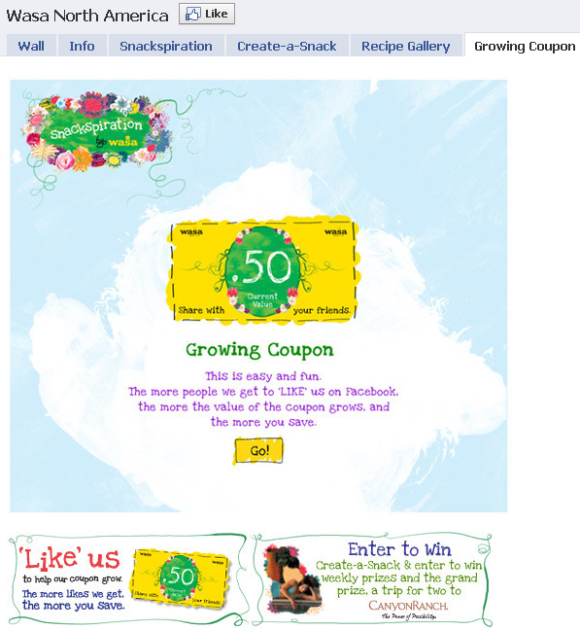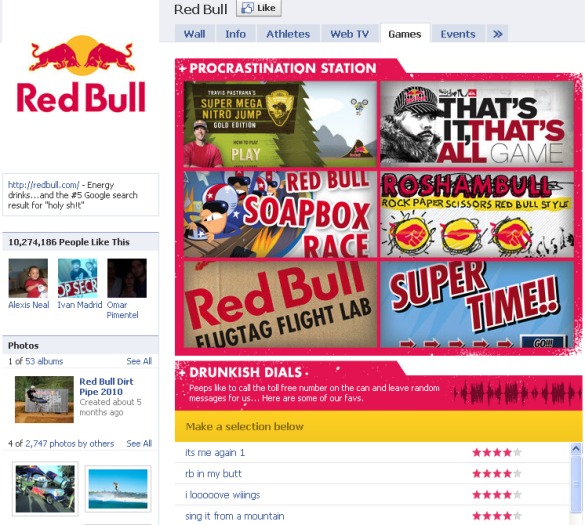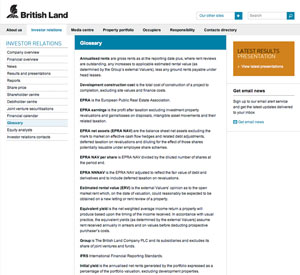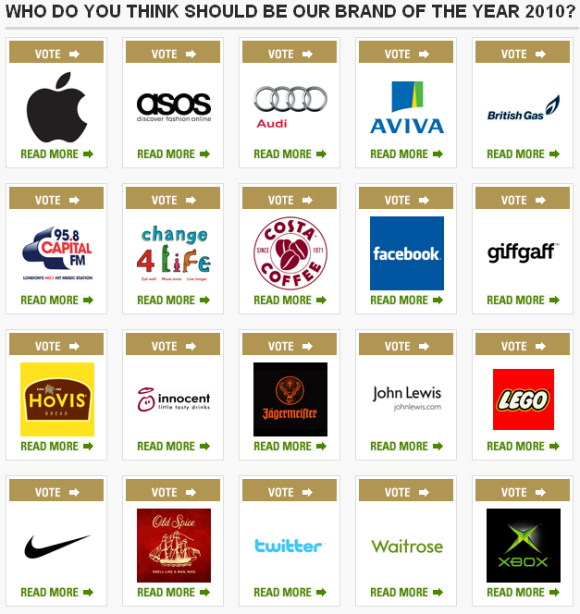- New Brand Marketing – More Facebook Likes Equals More SavingsConsumer products companies and retailers have been watching the success of social shopping site Groupon, and now, they’re trying to generate similar success through their own social media marketing efforts.
Groupon is a site that offers local shopping discounts to site members with a catch. The offers are very good, but shoppers can’t get a deal […] - Importance of Customer Geography to Internet RetailersThere is no question about the fact that internet retailers have the capability to reach new customers and clients that are far beyond the grasp of traditional brick and mortar establishments. Yet, despite the fact that anyone with access to the world wide web can reach an internet retailer, two recent papers published by the […]
- Marketing Society Votes on Top Brands of 2010The Marketing Society is a U.K.-based non-profit organization owned by its members — over 2,500 senior marketers. According to the Marketing Society website, “over the past 50 years it has emerged as one of the most influential drivers of marketing in the UK business community.” Each year, the Marketing Society Awards for Excellence […]
- 28 Brand Facebook Pages with the Most LikesHave you ‘liked’ a Facebook page lately? Creating Facebook pages for brands is hot, hot, hot! As you might expect, some brands are finding ways to get a lot of people to like their Facebook pages. Of course, there are no real numbers available to report how those likes turn into revenue, but the fact […]
- Time Warner Cable Sticks with Eye and EarIn March 2009, Time Warner Cable became its own, independent company. Since 1990, the eye and ear symbol used in the Time Warner brand identity has been an important element. In fact, in 1993, it began being used exclusively for Time Warner’s cable brand — Time Warner Cable. Throughout 2010, there have been rumors around […]
What Makes for Effective Investor Relations Sites? Part 30: Help Investors Understand Your Language
All businesses have specialized terms that they use in describing their business. In itself, there is nothing wrong with this, as such terms serve as a convenient shorthand and relieve the reader of the tedium of continually having something explained to them that they already know.
Things become a little murky however, when the shorthand terms get further reduced to acronyms and the reader is left wondering what the latest three or four letter combination means. It seems that the more specialized the industry, the greater the number of terms and acronyms get tossed around.
To take a simple example, in retail, comparable store sales, a common measure of sales for stores that have been open for a year or more are sometimes referred to as comps, same store sales, SSS, identical store sales and idents.
In the U.K., the very same measure is often referred to as Like for Like sales or LFL. An American investor looking at a British retail company, or a British investor looking at a U.S. merchant, will often find themselves scratching their heads trying to figure out if they understand what is being referred to.
There is a simple way to deal with this issue, although it does take some effort as it is not something your standard investor relations web site provider is likely to have ready to hand to you off the shelf. Companies with a need to explain their language to investors should create a glossary of terms and include it on their website. Clear and concise definitions can be set forth that will put the investor’s mind at ease that they understand what is being referred to in the discussion of operations.
A good example of how to do this is on the web site for the real estate developer and manager, British Land. Anyone that has ever dealt with real estate people will tell you that they tend to speak a different language. The concepts are the same as in classic finance – cash flow, returns on assets, capital and so forth, but they give everything a different name. So a glossary for the non-specialist is very helpful. And as you can see from the screenshot above, British Land does a nice job setting out explanations for the terms they think you ought to know. More companies should consider incorporating something similar into their IR web presence.
In this series:
Previous post: Context
New Brand Marketing – More Facebook Likes Equals More Savings
Consumer products companies and retailers have been watching the success of social shopping site Groupon, and now, they’re trying to generate similar success through their own social media marketing efforts.
Groupon is a site that offers local shopping discounts to site members with a catch. The offers are very good, but shoppers can’t get a deal until they get a specific number of other people to take that same offer. As more people join an offer, the better the deal gets. Groupon launched in November 2008 with 400 members, and today, Groupon has 25 million subscribers in 29 countries. With those huge numbers, it’s not surprising that most of the offers on Groupon attract enough users that they can cash in on those deals.
In recent weeks, many big brands have launched their own attempts at group buying and rising discounts, primarily through Facebook. Four such promotions are described below (via BrandWeek):
- Walmart: Walmart placed Facebook ads for its new CrowdSaver service offering an 18% discount off of a plasma television if they get 5,000 Facebook likes. 5,000 people quickly liked the Walmart Facebook page. Ultimately, Walmart will open the discount to all consumers, not just people who clicked the Facebook like button.
- Jack in the Box: Jack in the Box is running a promotion called “Be My Rich Fan” where the company created a virtual nickel jar and deposits a representative nickel each time a new person likes the Jack in the Box Facebook page. Over 213,000 people liked the Jack in the Box Facebook page before the promotion was over and the pot had grown to over $10,000. When the promotion ended, one of those followers won all the money in the virtual nickel jar (in real money).
- Healthy Choice: ConAgra Foods’ Healthy Choice brand offered a “progressive coupon” on the Healthy Choice Facebook page giving people who liked the page 75-cents off of their next purchase of a Healthy Choice product. As more people liked the Healthy Choice Facebook page (the number tripled within 25 hours of the promotion’s launch), the coupon got better until it reached it’s ultimate level of “buy one get one free” within three days.
- Barilla: Barilla offered a coupon for its Wasa Crispbread that grew in value as more people liked it on Facebook. Within a few weeks, the number of Facebook likes for Wasa Crispbread grew to nearly 8,000.

Clearly, if you offer savings, people will come, even if that discount seems small. Just look at the results for the 75-cent coupon for Healthy Choice! Even the ultimate buy-one-get-one-free coupon for Healthy Choice only equates to a few dollars! How engaged will those consumers stay in time if your brand doesn’t continue to offer coupons and other useful information? That part of the story has yet to be experienced. Will those thousands of Facebook likes turn into long-term, sustainable sales? Drawing attention and getting Facebook likes is just the beginning. It will be interesting to follow these brands in the future to see if they can retain the levels of interest they drew with their crowd couponing.
What do you think? Can you implement these types of tactics in your own business? Leave a comment and share your thoughts.
Importance of Customer Geography to Internet Retailers
 There is no question about the fact that internet retailers have the capability to reach new customers and clients that are far beyond the grasp of traditional brick and mortar establishments. Yet, despite the fact that anyone with access to the world wide web can reach an internet retailer, two recent papers published by the Wharton School of the University of Pennsylvania suggest that traditional methods of advertising and marketing are still important in growing an internet retailer’s brand. These methods include local word-of-mouth recommendations and even consideration of where customers live and in what conditions they are living.
There is no question about the fact that internet retailers have the capability to reach new customers and clients that are far beyond the grasp of traditional brick and mortar establishments. Yet, despite the fact that anyone with access to the world wide web can reach an internet retailer, two recent papers published by the Wharton School of the University of Pennsylvania suggest that traditional methods of advertising and marketing are still important in growing an internet retailer’s brand. These methods include local word-of-mouth recommendations and even consideration of where customers live and in what conditions they are living.
The research papers, authored by Wharton marketing professors David R. Bell and Leonard Lodish, as well as Yonsei University professor Jeonghye Choi, found that despite the internet’s worldwide appeal and access, locality still matters. When researchers compared the effects of online word of mouth recommendations and reviews on shoppers and the effects of offline word of mouth recommendations and reviews on shoppers, they found that offline recommendations tended to sway customer shopping habits more. Notably, this result was not only found in cases where the offline recommendation came from a trusted individual customers tended to be more swayed through offline word of mouth recommendations than online ones no matter who the recommendation came from. Customers buying from online vendors tended to buy more from those that have been recommended to them by people living nearby. This means that in the end, it all comes down to locality and geography.
Customers are more willing to trust the recommendations of someone who lives in their immediate area because they feel that they are experiencing similar living conditions, therefore the recommendation holds more clout. On the other hand, if they receive a recommendation from a trusted individual living in another part of the country, they will still give the recommendation strong thought, but not as much as they would if that recommendation had come from a next door neighbor. This is because the other individual lives far away, thereby making the purchaser feel as if the recommendation may not work out in the same way for the both of them because they experience different lifestyles and environments. This means that online recommendations are the least influential because not only are these reviews coming from strangers, but they are also coming from strangers who seem to only exist on the internet and therefore are not local at all.
One way that internet retailers can take advantage of this finding is by adding one extra little feature onto their customer reviews and recommendations: a location identifier. Some retailers have already done this, asking customers to identify where they live when leaving a review so that potential new customers looking through the reviews may be more influenced by the reviews if they happen to be from the same area as the reviewer.
Another thing for internet retailers to keep in mind is that the buying habits of customers vary from region to region. Retailers could find a wealth of new customers in areas where these customers are the minority. For example, if a town’s population is largely comprised of elderly residents, yet there is a sizeable amount of younger residents living there as well, Internet retailers could directly target these consumers. These consumers would likely latch onto an internet retailer because brick and mortar retailers in that area would cater only to the majority population, excluding the minority consumers. Retailers can research the demographics of specific areas and buy specific search keywords in places that have a trove of promising potential clients. This way, when potential customers in that area conduct an internet search for a particular product, retailers can ensure that their business will pop up in the search results.
Overall, retailers could benefit greatly from paying attention to where current and potential new customers live. This way, they can boost their brand reputation through localized product recommendations as well as tap into a wealth of new customers through localized keyword purchases. Though the internet is a decidedly global dominion, it still pays to think local.
This guest post is contributed by Olivia Coleman, who writes on the topics of online colleges and universities. She welcomes your comments at her email id: olivia.coleman33 @gmail.com.
The research papers are here:
Traditional and IS-enabled Customer Acquisition for an Internet Retailer: Why New Buyer Acquisition Varies over Geographies and by Method (PDF)
Local Preference Minorities and the Internet (PDF)
Marketing Society Votes on Top Brands of 2010
The Marketing Society is a U.K.-based non-profit organization owned by its members — over 2,500 senior marketers. According to the Marketing Society website, “over the past 50 years it has emerged as one of the most influential drivers of marketing in the UK business community.” Each year, the Marketing Society Awards for Excellence recognize the best-of-the-best, including the top brand.
Voting for the Marketing Society Top Brand of 2010 is open, and the winner will be decided during the Marketing Society Annual Conference on November 18, 2010 at Old Billingsgate, London, when 1200 marketers will choose the winner by live text vote.
You can check out the nominees for 2010 brand of the year below:
The nominees are very diverse and as you would expect from a U.K. based organization, there are a number of U.K. brands on the list. For example, Hovis (bakers with a long history) and John Lewis (a range of quality department stores owned by employees and much loved by Brits) are not well-known (or known at all) in the United States.
It will be interesting to see which brand takes the title as the top brand of 2010 by the Marketing Society voters. There are some interesting brand stories included amongst these logos, from the creative advertising of Old Spice that resurrected a brand to the rising global influence of the Twitter brand, each of these brands is included in the list of nominees for a very different reason. Which one actually deserves to be named brand of the year for 2010?
What do you think? Which brand would you vote for and why? I’m not from the U.K. and am not very familiar with several of these brands. Therefore, my vote would go to Twitter for the way it has changed the world of communications and achieved widespread use in 2010. Leave a comment and share your thoughts on who should be named 2010 brand of the year.
Image: Marketing Society
28 Brand Facebook Pages with the Most Likes
Have you ‘liked’ a Facebook page lately? Creating Facebook pages for brands is hot, hot, hot! As you might expect, some brands are finding ways to get a lot of people to like their Facebook pages. Of course, there are no real numbers available to report how those likes turn into revenue, but the fact that millions of people are liking brands on Facebook shows there is value in having a Facebook presence for your brand. If nothing else, it provides another way for consumers to interact with your brand in a way that they enjoy. It’s great for building brand awareness, loyalty, and word-of-mouth marketing, and it doesn’t have to cost a fortune to do it! What’s not to like about it?
TheNextWeb.com put together a list of the top 28 brand Facebook pages in terms of the number of people who like them, and the results are quite interesting. See which brands come out on top in the world of Facebook likes below:
- Starbucks (16,032,409)
- Coca Cola (15,095,389)
- Oreo (12,085,126)
- Skittles (11,508,441)
- Red Bull (10,198,875)
- Victoria’s Secret (8,429,334)
- Disney (8,394,141)
- Converse All Star (7,366,892)
- iTunes (7,071,721)
- MTV (7,043,056)
- Zara (6,063,583)
- Pringles (5,762,518)
- NBA (5,616,388)
- Starburst (5,380,056)
- Nutella (5,208,281)
- Dr Pepper (5,164,646)
- Monster Energy (4,916,536)
- Adidas Originals (4,804,224)
- H&M (4,520,070)
- Ferraro Rocher (4,424,751)
- McDonalds (3,795,486)
- Playstation (3,683,751)
- Xbox (3,447,690)
- Taco Bell (3,399,860)
- Puma (2,712,075)
- BMW (2,696,929)
- Blackberry (2,675,387)
- Nike (2,481,546)
Of course, there is more to finding success through Facebook marketing than attracting a lot of likes. How engaged are these millions of people on those Facebook pages a few months after they click the like button? In those terms, some of these Facebook pages are actually far superior than others. For example, take some time to look through the Facebook pages listed above and see what these brands are doing to engage consumers. Red Bull is one that definitely stands out to me. In fact, I included it in my upcoming book, 30-Minute Social Media Marketing, so I’m not surprised to see it on this list (listen to the Drunkish Dials on the Red Bull Facebook page, they’re hilarious). It’s a great example of adding value to the online conversation using Facebook.

I think one of the most interesting things about this list is how diverse it is. There are some of the most valuable brands in the world on this list as well as some smaller brands. There are also brands in a variety of categories, including food, apparel, entertainment, and more. Clearly, any size brand and type of brand can find success on Facebook.
Check out TheNextWeb.com for more information about these pages and start thinking about how you can benchmark these Facebook page leaders to market your brand through its own Facebook page.

